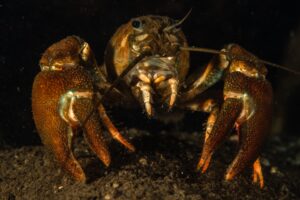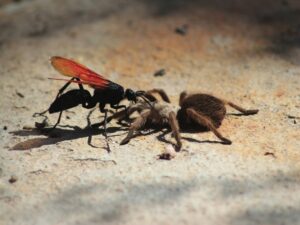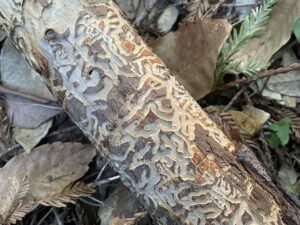
Here is the West Coast Painted Lady, Vanessa annabella, a butterfly native to San Francisco. Its brilliant orange-splattered wings, its quivering antennae, its very name, Latin and common, seem symbols of fair, delicate, fragile beauty.
Like most butterflies it has developed a deep, evolutionary relationship with a particular host plant, the violet-flowering checkerbloom and purple-flowering tree mallow. Checkerbloom and tree mallow bloom once a year, and every year when the time is right the delicate dance begins as the butterflies arrive, and lay their eggs, and then a few weeks later the caterpillars turn beautiful and fly.
Then the cheeseweed came to town. You know cheeseweed, by sight if not by name. It is widespread and grows in pretty much every vacant space in San Francisco. It is the Persians at Thermopylae of plant species: when one plant falls to the gardener, three more spring up to take its place.
All of which is fine to the West Coast Painted Lady, which shortly after the cheeseweed arrived decided it fancied the new bad boy in town. Butterflies are generalists anyway, willing to adapt to different host plants in the same family, and while humans here engage in a fantastic struggle to distinguish between native and non-native plants, the painted lady doesn’t; in fact, it found the cheeseweed’s year-round flowering a bonus. West Coast Painted Ladies in San Francisco, living off cheeseweed, have gone so far as to change their entire life cycle to accommodate the new host, going in the language of lepidoptery from univoltine — laying eggs once a year — to multivoltine — laying eggs year-round.
The fair, delicate fragile beauty turns out to be another creature out there that doesn’t really care how we label it or how we label the plants it lives on, and just wants to get on with things. It’s not alone: of the 35 breeding butterfly species in San Francisco, 25 have now found a non-native host plant they can work with. In an area this urban, undesirable weeds growing in sidewalk cracks have become vital to the life of butterflies.
“These are insects,” says lepidopterist Liam O’Brien. “They’ll move right in.”
(Let’s pause right here for what O’Brien calls the bold-print red disclaimer: You should not now go out and plant cheeseweed. This is purely a story about butterflies being clever, not a call to action.)

O’Brien has made a list of the 35 breeding species in San Francisco, their various native host plants, and their alternative non-native host plants. Of those 35, only the brilliant-orange tropical gulf fritillary is not native to the Bay Area and lays eggs on a not-native plant. (The fritillary is a cool story: in the 1930s a mania for the tropics spread through Hollywood and Southern Californians started to plant passionvine. As the passionvine spread out into California, the jungle-loving butterfly moved up from Mexico.)
While the native butterflies’ flexibility about host plants is a remarkable example of nature adapting to what it has to work with, the bigger story, O’Brien says, is the flyers that haven’t figured out a backup strategy. Call it pickiness, daintiness, snobbery — in the City, that stuff’ll get you killed.
The pipevine swallowtail relying on California pipevine, the green hairstreak and deerweed/wild buckwheat, the ringlet and skippers that rely on native grasses — they have to be the conservation priority. “A lot of this story is the 10 that don’t have a non-native host,” O’Brien says. “That’s a perilous place to be in an urbanized area.”
California pipevine isn’t particularly rare in the world at large, but the plant has been generally found on the margins of San Francisco: Strawberry Hill in Golden Gate Park, Brotherhood Way, and Yerba Buena Island. Likewise, the Northern California-native subspecies of pipevine swallowtail that relies on it isn’t endangered in the world at large, but could be lost to San Francisco.
“That butterfly never had a real strong hold on this place to begin with,” O’Brien says, and it’s now in a rough spot. The risk of the swallowtail’s singular focus on a single host, as O’Brien-favorite Robert Michael Pyle once wrote, is not so much extinction as the “extinction of experience,” the loss of one more thing that once was part of the fabric of San Francisco.
Some scientists like to call the modern era the “Homogocene,” because it’s an era that rewards the generalists and so will become homogenous. That’s depressing, perhaps, for people who want to preserve the planet as it is. But not for rats, or pigeons, or ivy — or cheeseweed or painted ladies. We don’t need to help any of them because they help themselves when we aren’t careful.
A few years ago, O’Brien says, a plant called the dwarf nettle became a thing. People wanted it for tea, and so it made its way into community gardens across San Francisco. Then it made its way out of community gardens across San Francisco.
The West Coast Painted Lady? Turns out it likes dwarf nettle too.




